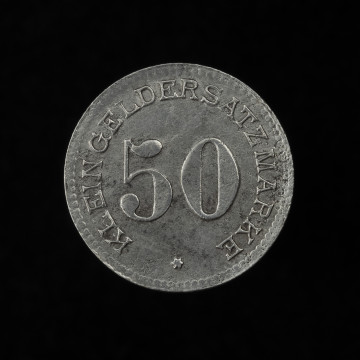
10 pfennig
1919
National Museum in Szczecin
Part of the collection: Scrip
During the First World War, Germany had to face not only Entente armies, but also economic problems and perturbations in the money market. Indeed, a large proportion of small coinage vanished from circulation, being eliminated by government institutions on the one hand and the public on the other. The 10 pfennig coins were particularly in great demand as they were used to operate the gas and electric meters found in households. Scarcity of coins on the money market was first attempted to be compensated by paper receipts or vouchers issued by municipalities and private companies, because the national mints proved inefficient and could not close the deficit. It soon became apparent, however, that the ad hoc paper money replacements produced from random materials quickly wore out as a result of the heavy circulation. From 1915 onwards, they began to be withdrawn, and, from 1916 onwards, replacement coins were introduced in their place as more durable and aesthetically pleasing. At first, they were minted in zinc, and since the end of 1917, in iron. Szczecinek also took advantage of the opportunity to improve trade with its own medium of exchange. At the commission of the magistrate, the coins of 5 and 10 pfennig were manufactured by L. Chr. Lauer in Nuremberg, probably in early 1917. They do not bear the year date but were struck in zinc, widely used at the time and have the octagonal shape typical of products produced in that period. According to historical sources, as many as 45,000 replacement coins worth 10 pfennig were still in circulation in June 1917. By comparison, there were only 5,000 5-pfennig coins. The ratio of the two figures demonstrates the huge demand for 10 pfennig coins on the money market. Mieszko Pawłowski
Other names
10 Pfennig, Notgeld
Author / creator
Object type
token coin
Technique
coining
Material
zinc
Origin / acquisition method
purchase
Creation time / dating
Creation / finding place
Owner
Muzeum Narodowe w Szczecinie (1945- )
Identification number
Location / status

1919
National Museum in Szczecin

1901 — 1925
National Museum in Szczecin

1901 — 1925
National Museum in Szczecin
DISCOVER this TOPIC
National Museum in Lublin
DISCOVER this PATH
Educational path